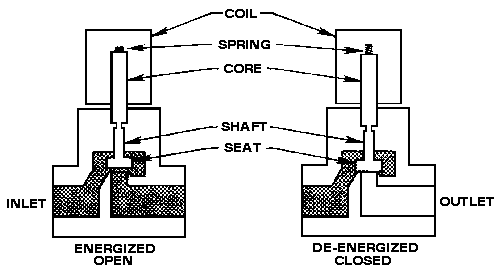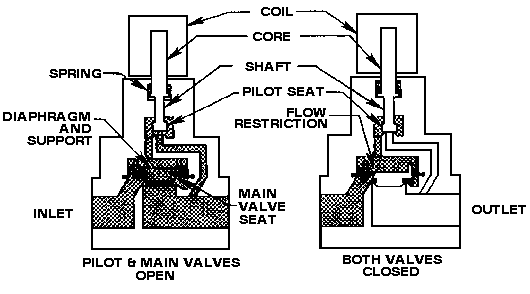I. WHAT styles of solenoid valves are available?
A. Direct-Acting Solenoid Valves - Direct-Acting Solenoid Valves open and close regardless of the pressure and flow: so long as the published maximum inlet and back pressure are not exceeded.
B. Pilot-Operated (Servo-Assisted) - In Pilot-Assisted Solenoid Valves, a minimum inlet pressure/differential pressure (typically 5 PSI) is required for the valve to operate.
II. HOW do they operate?
A. Direct-Acting - In Direct-Acting Solenoid Valves the energized coil magnetically pulls-up on the core, which is attached to the shaft and seat, thus overpowering the spring and opening the valve orifice. For closing, the coil is de-energized and the spring now pushes the core, shaft and seat back to the normally closed position. This style valve does not require any minimum line pressures nor differentials to operate. (See below)

Examples of Direct-Acting Solenoid Valves include Plast-O-Matic Series EASYMT/EASMT, EAST, EASYM, EASM, EASTMD/EASMD and EUC Models.
B. Pilot-Operated (Servo-Assisted) - These valves have a pilot valve seat with corresponding orifice, a main valve seat with corresponding orifice and a main valve diaphragm with a restriction orifice. The upper section of the valve consists of the pilot seat and orifice which is actually a small direct-acting solenoid valve. (see below)

The lower section of the valve consists of the main valve seat and orifice which is sealed by a diaphragm that allows liquid line pressure to pass thru a restriction orifice thus pressurizing the valve's upper pilot area (that area above the diaphragm and below the pilot seat). This pressure exerts a downward force on the top-side of the main diaphragm keeping it in the closed position. To open the main valve, the coil is energized, lifting the core, shaft and seat off the pilot orifice, allowing the pressure above the diaphragm to vent thru the pilot outlet to the down-stream side of the main valve. With no force now working in the top-side of the main diaphragm, the inlet line pressure lifts the diaphragm and opens the main orifice allowing full flow. To close the valve, the coil is de-energized and the spring pushes down on the core, shaft and seat, closing off the orifice, thus stopping the venting of the pressure, and therefore, re-pressurizing the top-side of the main diaphragm which causes it to close against the main seat to stop flow.
The new Plast-O-Matic Series "PS" is a Pilot-Operated Solenoid Valve.
III. WHERE would I use a Solenoid Valve?
Typically, Solenoid Valves are specified where:
A. Speed of cycling/operation is required.
B. A fail-safe (normally closed or normally open) bubble-tight sealing valve is required.
C. Physical size (and weight) requires a smaller valve.
D. Lower cost is required.
Keep in mind that solenoid coils are available in a variety of voltages, frequency and class ratings.
IV. WHY would I use a Solenoid Valve versus a Motorized Ball Valve?
A. Speed of Operation - Generally speaking, motorized ball valves have a cycle time of 5 to 6 seconds (full open to full closed) which is nowhere near as fast-acting as a direct-acting solenoid valve at approximately 30 to 40 milliseconds. Therefore, in applications requiring speed of cycling (such as PH control via electronic sensors) to prevent overshooting of chemicals, fast acting solenoid valves are preferred. Although pilot-operated solenoid valves (approximately one second closing time) are not as fast-acting as direct-acting valves, they are still considerably faster than motorized ball valves.
B. Fail-Safe Design - Motorized ball valves are not normally of fail-safe design. Yes, they can be made fail-safe but require a cumbersome and very costly add-on accessory, which is simply not practical. Conversely, solenoid valves are normally of a fail-safe design.
For futher assistance with your specific application involving solenoid valvesplease contact our Technical Sales Department at (973) 256-3000 or E-mail us at info@plastomatic.com
 Top of PageCopyright © 1999-2012 Plast-O-Matic Valves, Inc.
Top of PageCopyright © 1999-2012 Plast-O-Matic Valves, Inc.